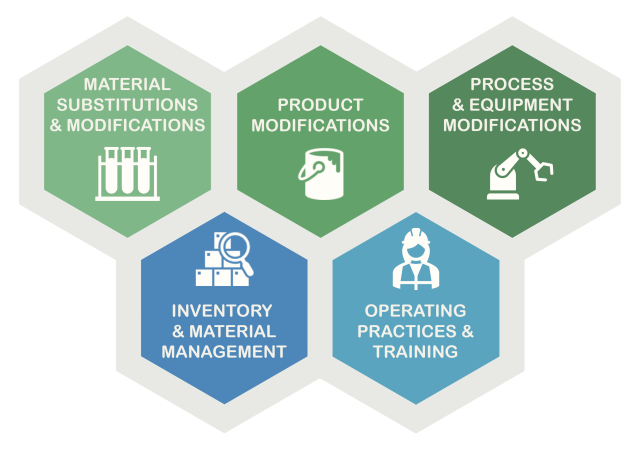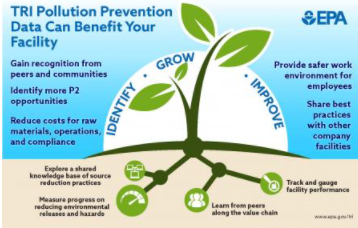TRI Source Reduction Reporting
TRI describes source reduction as activities implemented to prevent or reduce the amount of TRI chemicals entering any waste stream or otherwise released into the environment (including fugitive emissions) prior to recycling, energy recovery, treatment, or disposal.

TRI requires facilities to report any new source reduction activities implemented in whole or in part during the reporting year (e.g., improved loading procedures and substituting a non-TRI chemical).
Reported source reduction activities are grouped in five categories as shown in the diagram.
- Source reduction plant diagram
- Reporting source reduction activities
- Benefits of source reduction reporting
Source Reduction Plant Diagram
Activities may be implemented anywhere in an industrial facility. Facilities should consider their chemical usage holistically, looking at all processes to identify opportunities to eliminate the use of a TRI chemical or reduce the generation of TRI chemical waste. The diagram below depicts general activities at a facility, which also correspond to the source reduction categories that the TRI Program tracks. Click on each section to see a description of the category.
Text Descriptions of Source Reduction Categories
Material Substitutions and Modifications refer to changing input purity or dimensions, or replacing a raw material, feedstock, reagent, or other substance with environmentally preferable alternatives.
Product Modifications refer to changing the end product through design, composition, formulation, or packaging changes, as well as full final product replacements that reduce the generation of waste.
Process and Equipment Modifications refer to improvements to industrial processes and/or associated equipment including implementation of new processes that produce less waste, direct reuse of chemicals, or technological changes impacting synthesis, formulation, fabrication, and assembly, and surface treatment such as cleaning, degreasing, surface preparation, and finishing.
Inventory and Material Management refers to improvements in procurement, inventory tracking, preventative monitoring, and storage and handling of chemicals and materials as they move through a facility to optimize their use and prevent spills and leaks during operation.
Operating Practices and Training refers to improvements in maintenance, production scheduling, process monitoring, and other practices that enhance operator expertise and housekeeping measures that eliminate or minimize waste.
Reporting Source Reduction Activities
Each year, facilities are required to report their newly implemented source reduction activities by selecting the source reduction activity codes that align to the implemented practices. Refer to the related information box for resources.
Facilities are encouraged to provide optional comments with detail about their new source reduction practices so EPA and others can understand how the reductions are being achieved and promote best practices to incentivize industry-wide pollution prevention.
Benefits of Source Reduction Reporting

Analyzing over 25 years of TRI data shows that source reduction is effective at reducing the release of TRI chemicals into the environment. To learn more, refer to the summary on measuring the impact of source reduction.
EPA compiles and makes available source reduction information in a shared knowledgebase that promotes peer-to-peer learning, and often highlights noteworthy pollution prevention improvements in TRI outreach products, including the National Analysis and P2 Spotlight series.
For information on accessing, analyzing or using, TRI P2 information, see the TRI P2 webpage.
